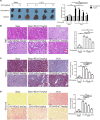N6-(2-Hydroxyethyl) Adenosine From Cordyceps cicadae Ameliorates Renal Interstitial Fibrosis and Prevents Inflammation via TGF-β1/Smad and NF-κB Signaling Pathway
- PMID: 30233405
- PMCID: PMC6131671
- DOI: 10.3389/fphys.2018.01229
N6-(2-Hydroxyethyl) Adenosine From Cordyceps cicadae Ameliorates Renal Interstitial Fibrosis and Prevents Inflammation via TGF-β1/Smad and NF-κB Signaling Pathway
Abstract
Renal interstitial fibrosis is characterized by inflammation and an excessive accumulation of extracellular matrix, which leads to end-stage renal failure. Our previous studies have shown that a natural product from Cordyceps cicadae can ameliorate chronic kidney diseases. N6-(2-Hydroxyethyl) adenosine (HEA), a physiologically active compound in C. cicadae, has been identified as a Ca2+ antagonist and an anti-inflammatory agent in pharmacological tests. However, its role in renal interstitial fibrosis and the underlying mechanism remains unclear. Here, unilateral ureteral obstruction (UUO) was used to induce renal interstitial fibrosis in male C57BL/6 mice. Different doses of HEA (2.5, 5, and 7.5 mg/kg) were given by intraperitoneal injection 24 h before UUO, and the treatment was continued for 14 days post-operatively. Histologic changes were examined by hematoxylin & eosin, Masson's trichrome, and picrosirius red stain. Quantitative real-time PCR analysis, enzyme-linked immunosorbent assays, immunohistochemistry, and western blot analysis were used to evaluate proteins levels. And the results showed that HEA significantly decreased UUO-induced renal tubular injury and fibrosis. In vivo, HEA apparently decreased UUO-induced inflammation and renal fibroblast activation by suppression of the NF-κB and TGF-β1/Smad signaling pathway. In vitro, HEA also obviously decreased lipopolysaccharide-induced inflammatory cytokine level in RAW 264.7 cells and TGF-β1-induced fibroblast activation in NRK-49F cells by modulating NF-κB and TGF-β1/Smad signaling. In general, our findings indicate that HEA has a beneficial effect on UUO-induced tubulointerstitial fibrosis by suppression of inflammatory and renal fibroblast activation, which may be a potential therapy in chronic conditions such as renal interstitial fibrosis.
Keywords: Cordyceps cicadae; N6-(2-hydroxyethyl) adenosine; inflammation; renal interstitial fibrosis; unilateral ureteral obstruction.
Figures







Similar articles
-
Tamoxifen ameliorates renal tubulointerstitial fibrosis by modulation of estrogen receptor α-mediated transforming growth factor-β1/Smad signaling pathway.Nephrol Dial Transplant. 2014 Nov;29(11):2043-53. doi: 10.1093/ndt/gfu240. Epub 2014 Jul 16. Nephrol Dial Transplant. 2014. PMID: 25031017
-
Anti-renal fibrosis effect of asperulosidic acid via TGF-β1/smad2/smad3 and NF-κB signaling pathways in a rat model of unilateral ureteral obstruction.Phytomedicine. 2019 Feb;53:274-285. doi: 10.1016/j.phymed.2018.09.009. Epub 2018 Sep 5. Phytomedicine. 2019. PMID: 30668407
-
N(6)-(2-Hydroxyethyl)adenosine in the Medicinal Mushroom Cordyceps cicadae Attenuates Lipopolysaccharide-Stimulated Pro-inflammatory Responses by Suppressing TLR4-Mediated NF-κB Signaling Pathways.J Nat Prod. 2015 Oct 23;78(10):2452-60. doi: 10.1021/acs.jnatprod.5b00573. Epub 2015 Sep 22. J Nat Prod. 2015. PMID: 26394068
-
Central role of dysregulation of TGF-β/Smad in CKD progression and potential targets of its treatment.Biomed Pharmacother. 2018 May;101:670-681. doi: 10.1016/j.biopha.2018.02.090. Epub 2018 Mar 22. Biomed Pharmacother. 2018. PMID: 29518614 Review.
-
TGF-β/Smad Signaling Pathway in Tubulointerstitial Fibrosis.Front Pharmacol. 2022 Mar 24;13:860588. doi: 10.3389/fphar.2022.860588. eCollection 2022. Front Pharmacol. 2022. PMID: 35401211 Free PMC article.
Cited by
-
Bioactive Metabolites and Potential Mycotoxins Produced by Cordyceps Fungi: A Review of Safety.Toxins (Basel). 2020 Jun 19;12(6):410. doi: 10.3390/toxins12060410. Toxins (Basel). 2020. PMID: 32575649 Free PMC article. Review.
-
Research Progress of Chinese Herbal Medicine Intervention in Renal Interstitial Fibrosis.Front Pharmacol. 2022 Jun 13;13:900491. doi: 10.3389/fphar.2022.900491. eCollection 2022. Front Pharmacol. 2022. PMID: 35770077 Free PMC article. Review.
-
Network Pharmacology-Based Exploration of the Therapeutic Mechanisms of Cordyceps cicadae in Renal Ischemia/Reperfusion.Ann Transplant. 2022 Sep 30;27:e937469. doi: 10.12659/AOT.937469. Ann Transplant. 2022. PMID: 36176185 Free PMC article.
-
Amelioration of Cyclosporine A-Induced Acute Nephrotoxicity by Cordyceps cicadae Mycelia via Mg+2 Reabsorption and the Inhibition of GRP78-IRE1-CHOP Pathway: In Vivo and In Vitro.Int J Mol Sci. 2023 Jan 1;24(1):772. doi: 10.3390/ijms24010772. Int J Mol Sci. 2023. PMID: 36614214 Free PMC article.
-
Identification of cordycepin biosynthesis-related genes through de novo transcriptome assembly and analysis in Cordyceps cicadae.R Soc Open Sci. 2018 Dec 19;5(12):181247. doi: 10.1098/rsos.181247. eCollection 2018 Dec. R Soc Open Sci. 2018. PMID: 30662735 Free PMC article.
References
LinkOut - more resources
Full Text Sources
Other Literature Sources
Miscellaneous

